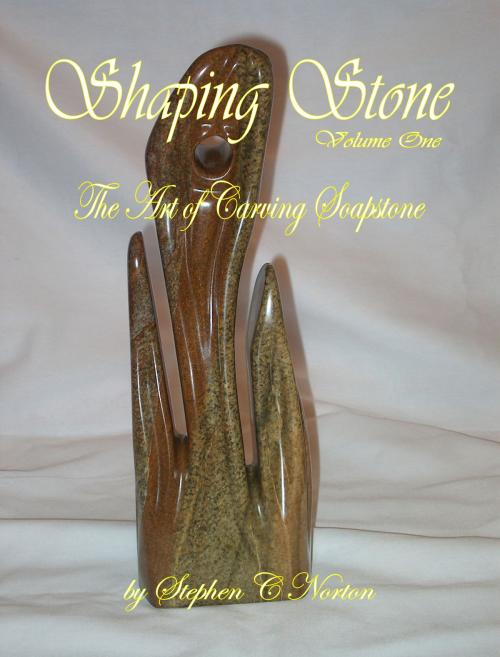Shaping Stone: Volume One - The Art of Carving Soapstone
Nonfiction, Home & Garden, Crafts & Hobbies, Art Technique, Art & Architecture, General Art| Author: | Stephen C Norton | ISBN: | 9781927343005 |
| Publisher: | Stephen C Norton | Publication: | October 21, 2011 |
| Imprint: | Smashwords Edition | Language: | English |
| Author: | Stephen C Norton |
| ISBN: | 9781927343005 |
| Publisher: | Stephen C Norton |
| Publication: | October 21, 2011 |
| Imprint: | Smashwords Edition |
| Language: | English |
A step by step guide to the techniques, tricks and tips on how to carve soapstone. Includes sections on how to select stone, what tools are required and recommended, how to use the tools, safety guidelines, how to finish and display soapstone carvings. Each step is clearly explained via both text and photographs. Included in the book are links to on-line videos of the various techniques and stages.
Whenever I display my work, I watch the people as they inspect the sculpture. Almost without exception, people are impelled to touch the stone, to stroke it with their fingertips. They are always surprised and fascinated by the silky texture, the smoothness and warmth of highly polished soapstone. Soapstone is almost unique in that fascination. Unlike metal or ceramic, soapstone calls out to the viewer, asking to be touched.
Soapstone can be found all over the world, and has been used by many cultures through-out history, from ancient Egypt, to India, China and the far North. Soapstone artifacts have been found which date as far back as 5000 BC. Today though, much of the world most commonly associates soapstone with the peoples of the North, once referred to as Eskimo, now more properly known as Inuit, Yupik and Aleut. Historically, these peoples used soapstone for many things, including dishes, bowls, cooking utensils, and, the most recognized, for carving and sculpting. Common motifs include seals, bears, walrus and other sea life, and also images of mythical or mystical beings, their creatures of belief and religion. Hand carved, using bone tools, sanded smooth using sand and soapstone dust, these carvings have evoked the North for centuries. When working with soapstone, I continually feel that almost spiritual aura that surrounds soapstone and its history. To work in soapstone today, one must also respect the culture and beliefs of those who first worked with the stone.
Having fallen in love with soapstone, and having carved for many years, I started giving introductory courses at the local collective which carries my artwork. Like my introductory course, this book shows you how to take a ragged block of uninteresting and dusty stone and turn it into a polished piece of art, something that calls to you, something you can touch, something you can be proud of. A piece of art that sings.
I’ve chosen to make this book pictorial rather than wordy. I’m a firm believer that a picture speaks a thousand words, so I’ve tried to show, and only talked enough to lead you into what the picture depicts. I’ve also chosen the size of the book so I can fit in lots of pictures, while keeping the pictures big enough that you can see the detail shown without needing a magnifying glass. At several points through-out the book, I point you to on-line videos so you can see the process in motion. Lastly, I’ve focused on giving you an overall introduction to soapstone carving, in order to keep the price of the book down so it’s affordable. I’ve deliberately left the more advanced and exotic techniques for a later book, so you don’t have to spend a great deal to begin this, your first journey into soapstone carving.
You don’t have to be an expert to follow the steps in this book. You don’t have to have any experience in carving, you simply need to have an interest, and a desire to create something. I will guide you through the process in eight easy-to-follow steps. You only need a few tools, though I show you other tools that can be useful. You can choose how much to invest and how many tools to buy. The basic tools can be purchased for twenty to forty dollars. The stone is reasonably easy to acquire and relatively inexpensive, usually no more than two to three dollars per pound, often less.
Sound interesting? Well, if you haven’t already done so, buy the book. Pick up a few tools if you don’t already have them at home. Go buy a chunk of soapstone, follow along with the book and let’s start carving.
A step by step guide to the techniques, tricks and tips on how to carve soapstone. Includes sections on how to select stone, what tools are required and recommended, how to use the tools, safety guidelines, how to finish and display soapstone carvings. Each step is clearly explained via both text and photographs. Included in the book are links to on-line videos of the various techniques and stages.
Whenever I display my work, I watch the people as they inspect the sculpture. Almost without exception, people are impelled to touch the stone, to stroke it with their fingertips. They are always surprised and fascinated by the silky texture, the smoothness and warmth of highly polished soapstone. Soapstone is almost unique in that fascination. Unlike metal or ceramic, soapstone calls out to the viewer, asking to be touched.
Soapstone can be found all over the world, and has been used by many cultures through-out history, from ancient Egypt, to India, China and the far North. Soapstone artifacts have been found which date as far back as 5000 BC. Today though, much of the world most commonly associates soapstone with the peoples of the North, once referred to as Eskimo, now more properly known as Inuit, Yupik and Aleut. Historically, these peoples used soapstone for many things, including dishes, bowls, cooking utensils, and, the most recognized, for carving and sculpting. Common motifs include seals, bears, walrus and other sea life, and also images of mythical or mystical beings, their creatures of belief and religion. Hand carved, using bone tools, sanded smooth using sand and soapstone dust, these carvings have evoked the North for centuries. When working with soapstone, I continually feel that almost spiritual aura that surrounds soapstone and its history. To work in soapstone today, one must also respect the culture and beliefs of those who first worked with the stone.
Having fallen in love with soapstone, and having carved for many years, I started giving introductory courses at the local collective which carries my artwork. Like my introductory course, this book shows you how to take a ragged block of uninteresting and dusty stone and turn it into a polished piece of art, something that calls to you, something you can touch, something you can be proud of. A piece of art that sings.
I’ve chosen to make this book pictorial rather than wordy. I’m a firm believer that a picture speaks a thousand words, so I’ve tried to show, and only talked enough to lead you into what the picture depicts. I’ve also chosen the size of the book so I can fit in lots of pictures, while keeping the pictures big enough that you can see the detail shown without needing a magnifying glass. At several points through-out the book, I point you to on-line videos so you can see the process in motion. Lastly, I’ve focused on giving you an overall introduction to soapstone carving, in order to keep the price of the book down so it’s affordable. I’ve deliberately left the more advanced and exotic techniques for a later book, so you don’t have to spend a great deal to begin this, your first journey into soapstone carving.
You don’t have to be an expert to follow the steps in this book. You don’t have to have any experience in carving, you simply need to have an interest, and a desire to create something. I will guide you through the process in eight easy-to-follow steps. You only need a few tools, though I show you other tools that can be useful. You can choose how much to invest and how many tools to buy. The basic tools can be purchased for twenty to forty dollars. The stone is reasonably easy to acquire and relatively inexpensive, usually no more than two to three dollars per pound, often less.
Sound interesting? Well, if you haven’t already done so, buy the book. Pick up a few tools if you don’t already have them at home. Go buy a chunk of soapstone, follow along with the book and let’s start carving.















